ASUS P9X79-E WS Review: Xeon meets PLX for 7x
by Ian Cutress on January 10, 2014 10:00 AM EST- Posted in
- Motherboards
- Asus
- Workstation
- X79
- Prosumer
Readers of our motherboard review section will have noted the trend in modern motherboards to implement a form of MultiCore Enhancement / Acceleration / Turbo (read our report here) on their motherboards. This does several things – better benchmark results at stock settings (not entirely needed if overclocking is an end-user goal), at the expense of heat and temperature, but also gives in essence an automatic overclock which may be against what the user wants. Our testing methodology is ‘out-of-the-box’, with the latest public BIOS installed and XMP enabled, and thus subject to the whims of this feature. It is ultimately up to the motherboard manufacturer to take this risk – and manufacturers taking risks in the setup is something they do on every product (think C-state settings, USB priority, DPC Latency / monitoring priority, memory subtimings at JEDEC). Processor speed change is part of that risk which is clearly visible, and ultimately if no overclocking is planned, some motherboards will affect how fast that shiny new processor goes and can be an important factor in the purchase.
Using our consumer level i7-4960X CPU, the P9X79-E WS does implement MultiCore Turbo when XMP is enabled. This gives a full 4.0 GHz CPU power under any loading.
Point Calculations - 3D Movement Algorithm Test
The algorithms in 3DPM employ both uniform random number generation or normal distribution random number generation, and vary in various amounts of trigonometric operations, conditional statements, generation and rejection, fused operations, etc. The benchmark runs through six algorithms for a specified number of particles and steps, and calculates the speed of each algorithm, then sums them all for a final score. This is an example of a real world situation that a computational scientist may find themselves in, rather than a pure synthetic benchmark. The benchmark is also parallel between particles simulated, and we test the single thread performance as well as the multi-threaded performance.
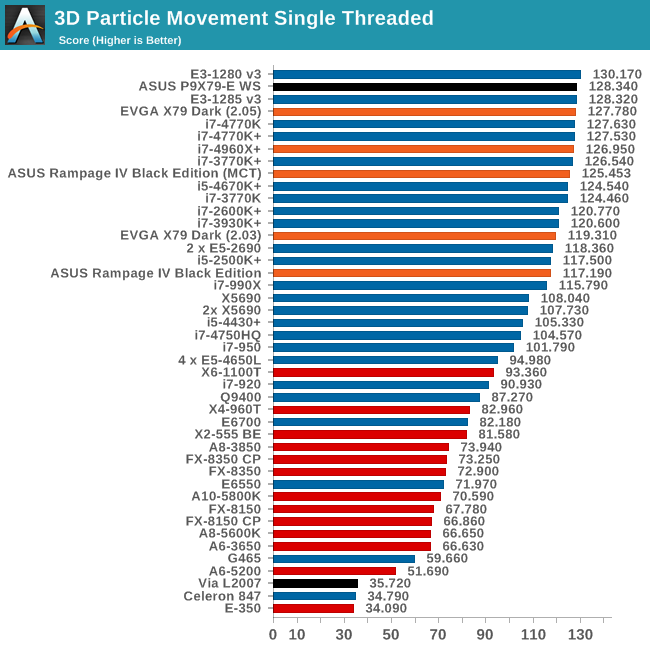

The P9X79-E WS results come across as very efficient in our 3DPM ST test, with none of the issues we found with the RIVBE coming through.
Compression - WinRAR 4.2
With 64-bit WinRAR, we compress the set of files used in the USB speed tests. WinRAR x64 3.93 attempts to use multithreading when possible, and provides as a good test for when a system has variable threaded load. WinRAR 4.2 does this a lot better! If a system has multiple speeds to invoke at different loading, the switching between those speeds will determine how well the system will do.
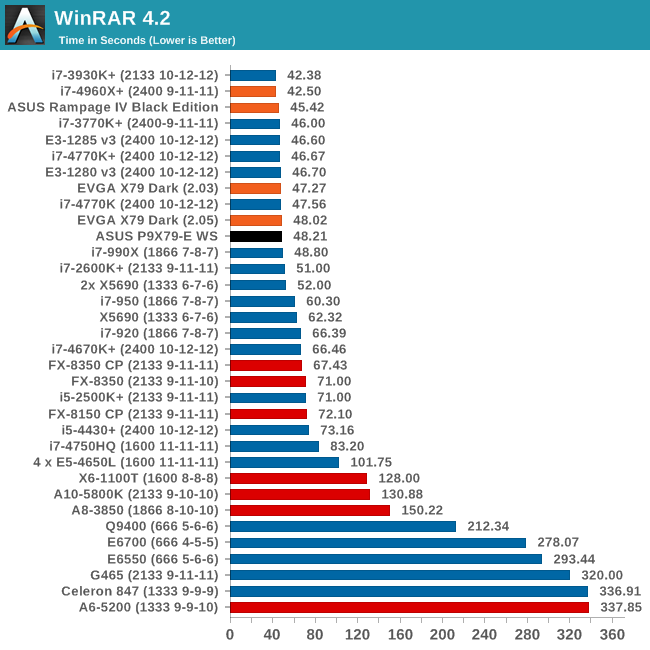
Image Manipulation - FastStone Image Viewer 4.2
FastStone Image Viewer is a free piece of software I have been using for quite a few years now. It allows quick viewing of flat images, as well as resizing, changing color depth, adding simple text or simple filters. It also has a bulk image conversion tool, which we use here. The software currently operates only in single-thread mode, which should change in later versions of the software. For this test, we convert a series of 170 files, of various resolutions, dimensions and types (of a total size of 163MB), all to the .gif format of 640x480 dimensions.

Again, the P9X79-E WS blasts past the RIVBE here due to the turbo issue.
Video Conversion - Xilisoft Video Converter 7
With XVC, users can convert any type of normal video to any compatible format for smartphones, tablets and other devices. By default, it uses all available threads on the system, and in the presence of appropriate graphics cards, can utilize CUDA for NVIDIA GPUs as well as AMD WinAPP for AMD GPUs. For this test, we use a set of 33 HD videos, each lasting 30 seconds, and convert them from 1080p to an iPod H.264 video format using just the CPU. The time taken to convert these videos gives us our result.
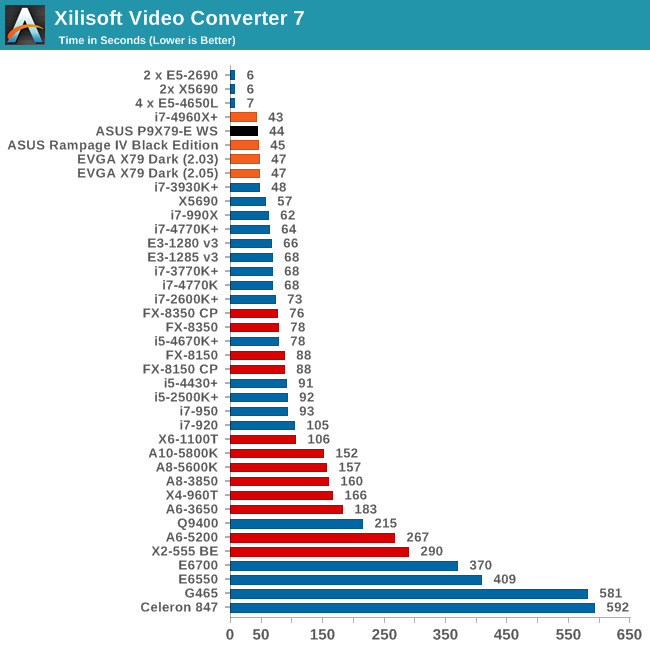
Rendering – PovRay 3.7
The Persistence of Vision RayTracer, or PovRay, is a freeware package for as the name suggests, ray tracing. It is a pure renderer, rather than modeling software, but the latest beta version contains a handy benchmark for stressing all processing threads on a platform. We have been using this test in motherboard reviews to test memory stability at various CPU speeds to good effect – if it passes the test, the IMC in the CPU is stable for a given CPU speed. As a CPU test, it runs for approximately 2-3 minutes on high end platforms.
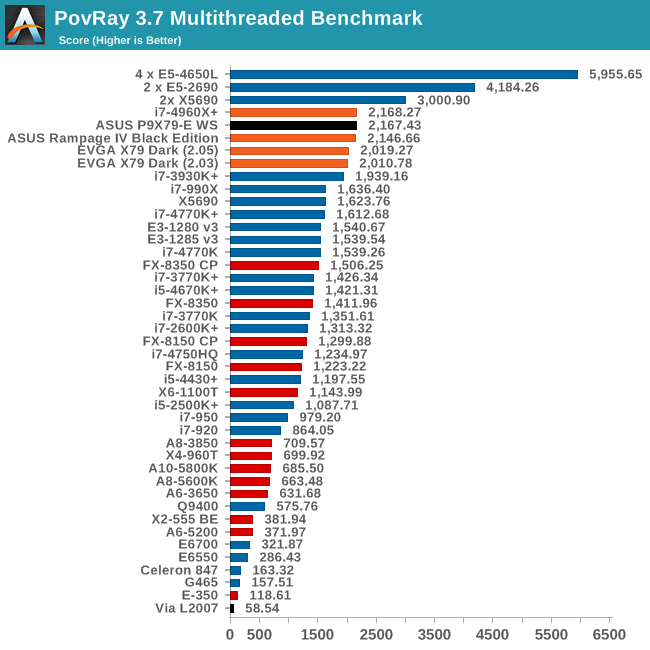
Video Conversion - x264 HD Benchmark
The x264 HD Benchmark uses a common HD encoding tool to process an HD MPEG2 source at 1280x720 at 3963 Kbps. This test represents a standardized result which can be compared across other reviews, and is dependent on both CPU power and memory speed. The benchmark performs a 2-pass encode, and the results shown are the average of each pass performed four times.
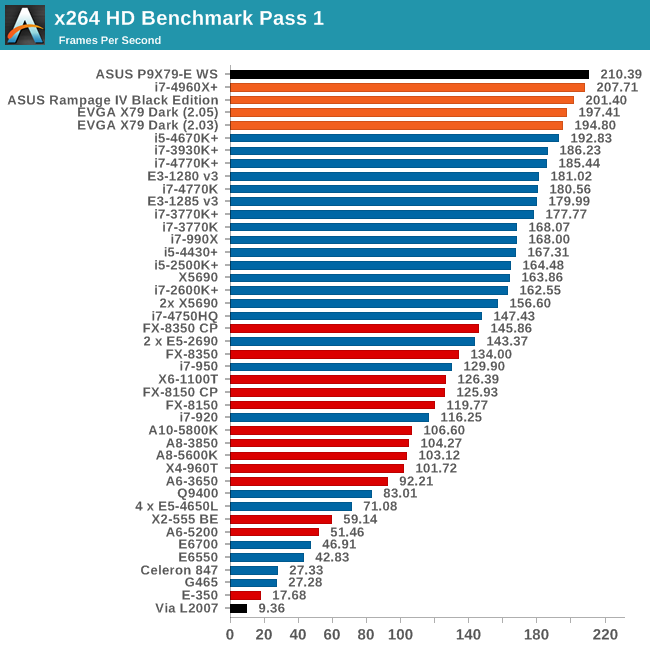
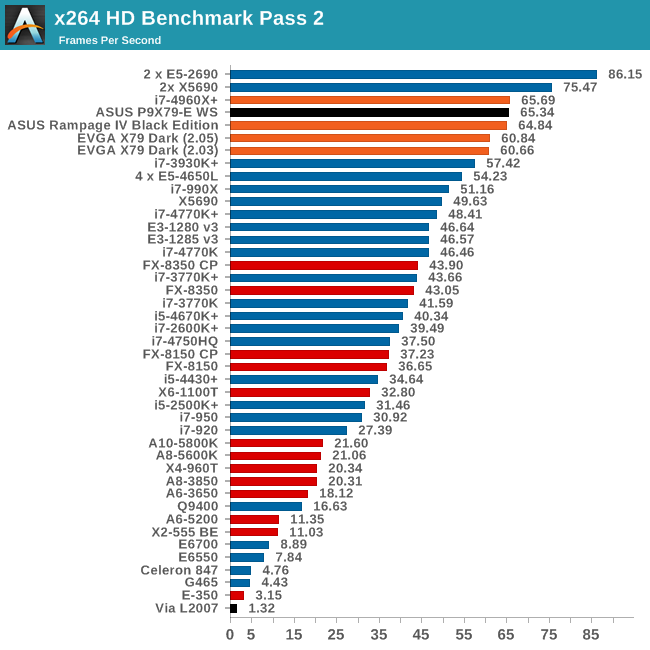
Grid Solvers - Explicit Finite Difference
For any grid of regular nodes, the simplest way to calculate the next time step is to use the values of those around it. This makes for easy mathematics and parallel simulation, as each node calculated is only dependent on the previous time step, not the nodes around it on the current calculated time step. By choosing a regular grid, we reduce the levels of memory access required for irregular grids. We test both 2D and 3D explicit finite difference simulations with 2n nodes in each dimension, using OpenMP as the threading operator in single precision. The grid is isotropic and the boundary conditions are sinks. Values are floating point, with memory cache sizes and speeds playing a part in the overall score.
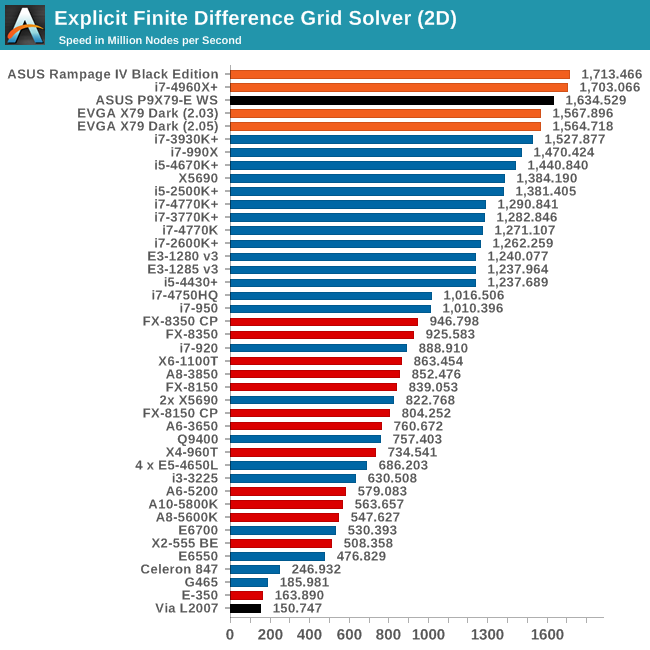
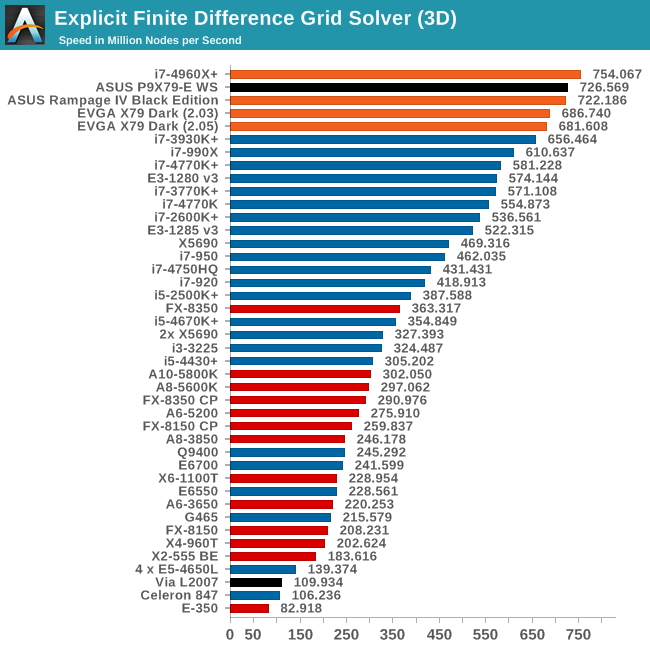
Interestingly something seems to be holding back the 2D Explicit numbers.
Grid Solvers - Implicit Finite Difference + Alternating Direction Implicit Method
The implicit method takes a different approach to the explicit method – instead of considering one unknown in the new time step to be calculated from known elements in the previous time step, we consider that an old point can influence several new points by way of simultaneous equations. This adds to the complexity of the simulation – the grid of nodes is solved as a series of rows and columns rather than points, reducing the parallel nature of the simulation by a dimension and drastically increasing the memory requirements of each thread. The upside, as noted above, is the less stringent stability rules related to time steps and grid spacing. For this we simulate a 2D grid of 2n nodes in each dimension, using OpenMP in single precision. Again our grid is isotropic with the boundaries acting as sinks. Values are floating point, with memory cache sizes and speeds playing a part in the overall score.
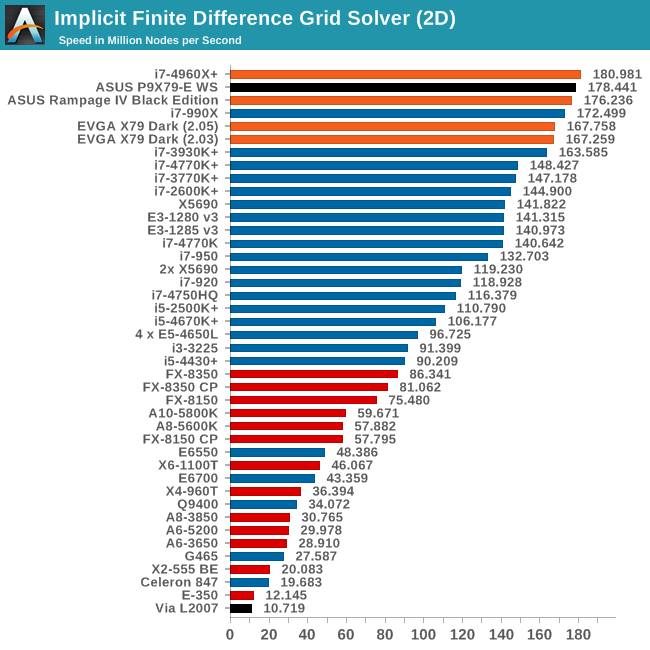
Point Calculations - n-Body Simulation
When a series of heavy mass elements are in space, they interact with each other through the force of gravity. Thus when a star cluster forms, the interaction of every large mass with every other large mass defines the speed at which these elements approach each other. When dealing with millions and billions of stars on such a large scale, the movement of each of these stars can be simulated through the physical theorems that describe the interactions. The benchmark detects whether the processor is SSE2 or SSE4 capable, and implements the relative code. We run a simulation of 10240 particles of equal mass - the output for this code is in terms of GFLOPs, and the result recorded was the peak GFLOPs value.











53 Comments
View All Comments
pewterrock - Friday, January 10, 2014 - link
Intel Widi-capable network card (http://intel.ly/1iY9cjx) or if on Windows 8.1 use Miracast (http://bit.ly/1ktIfpq). Either will work with this receiver (http://amzn.to/1lJjrYS) at the TV or monitor.dgingeri - Friday, January 10, 2014 - link
WiDi would only work for one user at a time. It would have to be a Virtual Desktop type thing like extide mentions, but, as he said, that doesn't work too well for home user activities. Although, it could be with thin-clients: one of these for each user http://www.amazon.com/HP-Smart-Client-T5565z-1-00G...eanazag - Wednesday, January 15, 2014 - link
Yes and no. Virtual Desktops exist and can be done. Gaming is kind of a weak and expensive option. You can allocate graphics cards to VMs, but latency for screen are not going to be optimal for the money. Cheaper and better to go individual systems. If you're just watchnig youtube and converting video it wouldn't be a bad option and can be done reasonably. Check out nVidia's game streaming servers. It exists. The Grid GPUs are pushing in the thousands of dollars, but you would only need one. Supermicro has some systems that, I believe, fall into that category. VMware and Xenserver/Xendesktop can share the video cards as the hypervisors. Windows server with RemoteFX may work better. I haven't tried that.extide - Friday, January 10, 2014 - link
Note: At the beginning of the article you mention 5 year warranty but at the end you mention 3 years. Which is it?Ian Cutress - Friday, January 10, 2014 - link
Thanks for pointing the error. I initially thought I had read it as five but it is three.Li_Thium - Friday, January 10, 2014 - link
At last...triple SLI with space between from ASUS.Plus one and only SLI bridge: ASRock 3way 2S2S.
artemisgoldfish - Friday, January 10, 2014 - link
I'd like to see how this board compares against an x16/x16/x8 board with 3 290Xs (if thermal issues didn't prevent this). Since they communicate from card to card through PCIe rather than a Crossfire bridge, a card in PCIe 5 communicating with a card in PCIe 1 would have to traverse the root complex and 2 switches. Wonder what the performance penalty would be like.mapesdhs - Friday, January 10, 2014 - link
I have the older P9X79 WS board, very nice BIOS to work with, easy to setup a good oc,
currently have a 3930K @ 4.7. I see your NV tests had two 580s; aww, only two? Mine
has four. :D (though this is more for exploring CUDA issues with AE rather than gaming)
See: http://valid.canardpc.com/zk69q8
The main thing I'd like to know is if the Marvell controller is any good, because so far
every Marvell controller I've tested has been pretty awful, including the one on the older
WS board. And how does the ASMedia controller compare? Come to think of it, does
Intel sell any kind of simple SATA RAID PCIe card which just has its own controller so
one can add a bunch of 6gbit ports that work properly?
Should anyone contemplate using this newer WS, here are some build hints: fans on the
chipset heatsinks are essential; it helps a lot with GPU swapping to have a water cooler
(I recommend the Corsair H110 if your case can take it, though I'm using an H80 since
I only have a HAF 932 with the PSU at the top); take note of what case you choose if you
want to have a 2/3-slot GPU in the lowest slot (if so, the PSU needs space such as there
is in an Aerocool X-Predator, or put the PSU at the top as I've done with my HAF 932);
and if multiple GPUs are pumping out heat then remove the drive cage & reverse the front
fan to be an exhaust.
Also, the CPU socket is very close to the top PCIe slot, so if you do use an air cooler,
note that larger units may press right up against the back of the top-slot GPU (a Phanteks
will do this, the cooler I originally had before switching to an H80).
I can mention a few other things if anyone's interested, plus some picture build links. All
the same stuff would apply to the newer E version. Ah, an important point: if one upgrades
the BIOS on this board, all oc profiles will be erased, so make sure you've either used the
screenshot function to make a record of your oc settings, or written them down manually.
Btw Ian, something you missed which I think is worth mentioning: compared to the older
WS, ASUS have moved the 2-digit debug LED to the right side edge of the PCB. I suspect
they did this because, as I discovered, with four GPUs installed one cannot see the debug
display at all, which is rather annoying. Glad they've moved it, but a pity it wasn't on the
right side edge to begin with.
Hmm, one other question Ian, do you know if it's possible to use any of the lower slots
as the primary display GPU slot with the E version? (presumably one of the blue slots)
I tried this with the older board but it didn't work.
Ian.
PS. Are you sure your 580 isn't being hampered in any of the tests by its meagre 1.5GB RAM?
I sourced only 3GB 580s for my build (four MSI Lightning Xtremes, 832MHz stock, though they
oc like crazy).
Ian Cutress - Saturday, January 11, 2014 - link
Dual GTX 580s is all I got! We don't all work in one big office at AnandTech, as we are dotted around the world. It is hard to source four GPUs of exactly the same type without laying down some personal cash in the process. That being said, for my new 2014 benchmark suite starting soon, I have three GTX 770 Lightnings which will feature in the testing.On the couple of points:
Marvell Controller: ASUS use this to enable SSD Caching, other controllers do not do it. That is perhaps at the expense of speed, although I do not have appropriate hardware (i.e. two drives in RAID 0 suitable of breaking SATA 6 Gbps) connected via SATA. Perhaps if I had something like an ACARD ANS-9010 that would be good, but sourcing one would be difficult, as well as being expensive.
Close proximity to first PCIe: This happens with all motherboards that use the first slot as a PCIe device, hence the change in mainstream boards to now make that top slot a PCIe x1 or nothing at all.
OC Profiles being erased: Again, this is standard. You're flashing the whole BIOS, OC Profiles included.
2-Digit Debug: The RIVE had this as well - basically any board where ASUS believes that users will use 4 cards has it moved there. You also need an E-ATX layout or it becomes an issue with routing (at least more difficult to trace on the PCB).
Lower slots for GPUs: I would assume so, but I am not 100%. I cannot see any reason why not, but I have not tested it. If I get a chance to put the motherboard back on the test bed (never always easy with a backlog of boards waiting to be tested) I will attempt.
GPU Memory: Perhaps. I work with what I have at the time ;) That should be less of an issue for 2014 testing.
-Ian
mapesdhs - Saturday, January 11, 2014 - link
Ian Cutress writes:
> ... It is hard to source four GPUs of exactly the same type without
> laying down some personal cash in the process. ...
True, it took a while and some moolah to get the cards for my system,
all off eBay of course (eg. item 161179653299).
> ... I have three GTX 770 Lightnings which will feature in the testing.
Sounds good!
> Marvell Controller: ASUS use this to enable SSD Caching, other controllers do not do it.
So far I've found it's more useful for providing RAID1 with mechanical drives.
A while ago I built an AE system using the older WS board; 3930K @ 4.7, 64GB @ 2133,
two Samsung 830s on the Intel 6gbit ports (C-drive and AE cache), two Enterprise SATA
2TB on the Marvell in RAID1 for long term data storage. GPUs were a Quadro 4000 and
three GTX 580 3GB for CUDA.
> (i.e. two drives in RAID 0 suitable of breaking SATA 6 Gbps) ...
I tested an HP branded LSI card with 512MB cache, behaved much as expected:
2GB/sec for accesses that can exploit the cache, less than that when the drives
have to be read/written, scaling pretty much based on the no. of drives.
> Close proximity to first PCIe: This happens with all motherboards that use the first
> slot as a PCIe device, hence the change in mainstream boards to now make that top slot
> a PCIe x1 or nothing at all.
It certainly helps with HS spacing on an M4E.
> OC Profiles being erased: Again, this is standard. You're flashing the whole BIOS, OC
> Profiles included.
Pity they can't find a way to preserve the profiles though, or at the very least
include a warning when about to flash that the oc profiles are going to be wiped.
> 2-Digit Debug: The RIVE had this as well - basically any board where ASUS believes
> that users will use 4 cards has it moved there. ...
Which is why it's a bit surprising that the older P9X79 WS doesn't have it on the edge.
> Lower slots for GPUs: I would assume so, but I am not 100%. I cannot see any reason
> why not, but I have not tested it. If I get a chance to put the motherboard back on
> the test bed (never always easy with a backlog of boards waiting to be tested) I will
> attempt.
Ach I wouldn't worry about it too much. It was a more interesting idea with the older
WS because the slot spacing meant being able to fit a 1-slot Quadro in a lower slot
would give a more efficient slot usage for 2-slot CUDA cards & RAID cards.
> GPU Memory: Perhaps. I work with what I have at the time ;) That should be less of an
> issue for 2014 testing.
I asked because of my experiences of playing Crysis2 at max settings just at 1920x1200
on two 1GB cards SLI (switching to 3GB cards made a nice difference). Couldn't help
wondering if Metro, etc., at 1440p would exceed 1.5GB.
Ian.